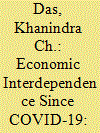|
|
|
Sort Order |
|
|
|
Items / Page
|
|
|
|
|
|
|
| Srl | Item |
| 1 |
ID:
184103


|
|
|
|
|
| Summary/Abstract |
In the backdrop of COVID-19-induced geo-political backlash against China, the article makes an assessment of the nature of economic interdependence of South Asian nations with China. Though COVID-19-induced lockdown led to a decline in trade with China, it recovered quickly in subsequent months. In the case of India, even after imposing restrictive measures, trade with China was found to bounce back indicating to a greater dependence on China. Further, asymmetry in economic engagement with China could be observed for several of the South Asian nations. Chinese investment in the region remained muted during the pandemic. However, strategic involvement in South Asia by China, and other powers, increased considerably which has been manifested by her provisioning of economic incentives and COVID-19-related aid. In the light of increasing strategic influence, South Asian countries desirous of benefitting from foreign trade and investment in their respective economies will need to encourage free and fair competition rather than towing geo-political lines so that sustainable economic gains can be made, which will require strengthening of various market supporting institutions in the respective economies. India’s economic strategy will also assume significance in boosting confidence and increasing the level of integration within South Asia.
|
|
|
|
|
|
|
|
|
|
|
|
|
|
|
|
| 2 |
ID:
117679


|
|
|
|
|
| Publication |
2013.
|
| Summary/Abstract |
This article examines various home country determinants of outward FDI from developing economies, which have received limited attention in empirical studies. The role of home country determinants is investigated for a large sample of developing economies, as against a handful of developing economies, for the most recent period, 1996-2010, using a panel data econometric framework. The results indicate that source country's level of economic development, globalisation, political risk and science and technology investments contribute significantly to outward FDI from developing countries. While outward FDI might be unavoidable in the course of economic development and globalisation, developing countries need to emphasise improving political governance in order to prevent capital outflow arising out of high domestic political risk. On the flip side, science and technology investments could contribute to higher outward FDI, thereby yielding complementary benefits of internationalisation in the long-run. Thus, given the evolving role of developing countries in the global economic scenario, a balance between domestic and international investments is crucial for them to harness the benefits of globalisation, which can be achieved through suitable governance and policy reforms in specific fields.
|
|
|
|
|
|
|
|
|
|
|
|
|
|
|
|
| 3 |
ID:
139977


|
|
|
|
|
| Summary/Abstract |
Chinese and Indian enterprises have been increasingly involved in international business thereby attracting global attention since the turn of the 21st century. This article examines outbound investment experiences of Chinese and Indian multinationals and compares and contrasts the investment development trajectory for both the countries. The comparisons and contrasts are made with respect to government policy, motivations for outbound investment, financing of investment, success rate in overseas acquisition, sectoral composition, characteristics of multinational enterprises (MNEs), and the challenges and impact of such investments in the light of differences in economic and institutional parameters between the two countries. It can be observed that there are more differences than similarities in the trajectory of outbound investments by Chinese and Indian enterprises. These differences arise due to the economic and institutional structure and the development path chosen by the two countries. Due to the differences between Chinese and Indian economic development trajectories, which are unique in many ways, it is not meaningful to make a straightforward comparison of outbound foreign direct investment (FDI) experience of the two countries. Nevertheless, the main differences with regard to outward investment by Indian and Chinese enterprises can be observed in areas such as the degree of involvement of the public sector enterprises, financing of overseas investments, success rate of proposed mergers and acquisitions (M&A), sectoral composition of such investments, investment motives, and so on. Various challenges facing outward FDI from China and India are highlighted, some of which could be addressed by specific economic and institutional reforms. The tale of the two countries examined in this article taken together contains important insights for emerging country enterprises and governments on the challenges and opportunities of global business.
|
|
|
|
|
|
|
|
|
|
|
|
|
|
|
|
|
|
|
|
|